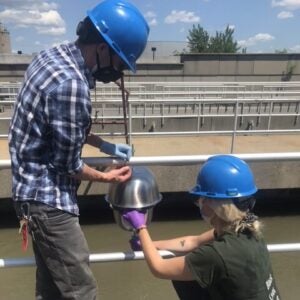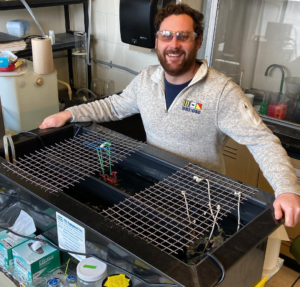Passive Samplers
Passive samplers are a convenient and inexpensive alternative to traditional air and water sampling methods. Hydrophobic pollutants partition into the plastic sampler during the deployment period, providing a time-integrated measurement of levels at the sampling site. The Lohmann Lab has used polyethylene passive samplers, or “PEs,” to measure hydrophobic organic contaminants in diverse environments, from the Great Lakes and the Passaic River to remote areas of the Atlantic Ocean and the deep Arctic. Active areas of research include applying passive sampler technologies to new contaminant classes and determining the sampling rates and partitioning behavior of a wide variety of pollutants in air and water.


Novel Detection Tools
Develop passive samplers for the detection and bioaccumulation of poly- and perfluoroalkyl substances (PFAS) in water and porewater, via the NIEHS Superfund Research Program: Sources, Transport, Exposure and Effects of PFAS (STEEP).
This project is developing, validating, and deploying novel passive samplers for the detection of PFAS in water and porewater (water in the sediment). At contaminated sites, as the extent of a PFAS plume is investigated, benefits of field-validated passive sampling approaches include ease of handling, shipping, and analysis; reduced potential for contamination; and lower detection limits that will be needed as regulatory agencies adjust their references doses.
This project will:
- Develop a porewater fiber for measuring PFAS concentrations.
- Collaborate with U.S. Environmental Protection Agency to determine PFAS accumulation in bivalves (e.g., mussels and oysters), and compare these results to the novel passive samplers.
- Validate PFAS passive sampling tools.
Black Carbon
Black carbon is formed during the incomplete burning of fuels (e.g., the black clouds of smoke emitted by buses and trucks). Black carbon does not degrade easily in the environment and can be transported long distances, even reaching the seafloor. Yet the fluxes of black carbon in the environment are not well known, particularly in the oceans. Rivers are considered the dominant source of black carbon to the oceans. However, recent results suggest that there may be regions of the ocean where the atmospheric delivery of black carbon may be important.
This study investigates whether biomass burning (e.g., wildfires) in Africa is a source of black carbon to the tropical Atlantic Ocean. The unique molecular and isotopic properties of black carbon will be used to identify black carbon in the atmosphere, water and sediment in the study region. Sediment, water column and atmospheric particles will be collected during a 3-week research cruise across the tropical Atlantic Ocean. Two different approaches will be used to quantify black carbon in the environment. The research is relevant and timely for our understanding of the carbon cycle, a key component of our ability to forecast climate and its change. The project supports a graduate student and provide opportunities for high school students participating in the SMILE Program (Science and Math Investigative Learning Experiences).
Bioaccumulation of contaminants
Several projects address concerns on the presence of legacy pollutants (PCBs, DDT, but also PFOS) and novel contaminants in different trophic levels, from plankton to fish and birds. To better assess bioaccumulation, and the potential for biomagnification, projects often also involve passive sampling tools to derive freely dissolved concentrations. Separate efforts also gauge to what degree passive samplers can be use to predict bioaccumulation directly.
Global Efforts
Global PFAS Science Panel
The Global PFAS Science Panel is a collaborative partnership among academic researchers, regulatory scientists and policy analysts dedicated to enhancing understanding of per- and polyfluoroalkyl substances (PFAS) and to protecting human and environmental health from potentially adverse effects associated with PFAS through better informed decision-making. The mission is to foster development of high-quality scientific research, steward information exchange, and coordinate advancement of science and policy to address the class of per- and polyfluoroalkyl substances (PFASs) as a global concern.
The panel first established the concept of Essential use to limit the use of PFAS. This concept has explicitly been taken up the EU and the state of Maine, but implicitly by phasing out the use of PFAS in specific product categories in many US states, including RI, with its ban on PFAS in food contact materials.
Board of International Panel on Chemical Pollution
The goal of the IPCP is to collect scientific knowledge about issues of chemical pollution and to provide summaries and interpretations of the available knowledge for decision makers and the public.
Many scientific studies have been and are being conducted to understand the increasing production and diversification of chemicals in use and waste, their associated harm, and ways to manage them. Yet, international policy-makers do not have a global mechanism to stay informed regarding the up-to-date scientific evidence, limiting their ability to identify and address these threats in a timely manner, as explained in this article from Science (free access).
We recommend establishing a global science-policy interface body for all chemicals and waste.A sign-on campaign was supported by over 2100 scientists from > 90 countries. The UN Env Program has set up an Open Ended working group to establish a panel on Chemicals and Waste.
AQUA-GAPS/MONET network
Inspired by the success of the Global Atmospheric Passive Sampling (GAPS) program, a group of scientists with support from Jinan University (Guangzhou, China) and Centre RECETOX from Masaryk University (Brno, Czech Republic) met in 2016 to discuss how to set up a global sampling initiative relying on passive samplers in the waters of the world, named AQUA-GAPS. Within the initiative, RECETOX research infrastructure took the role of a central laboratory by providing the chemical analysis, data reporting and storage by its MONET monitoring network. The AQUA-GAPS/MONET program has deployed passive samplers at over 40 sites across the globe, and we expect publishing first results this spring. Rainer Lohmann is co-leader & initiator behind the AQUA-GAPS/MONET network.
